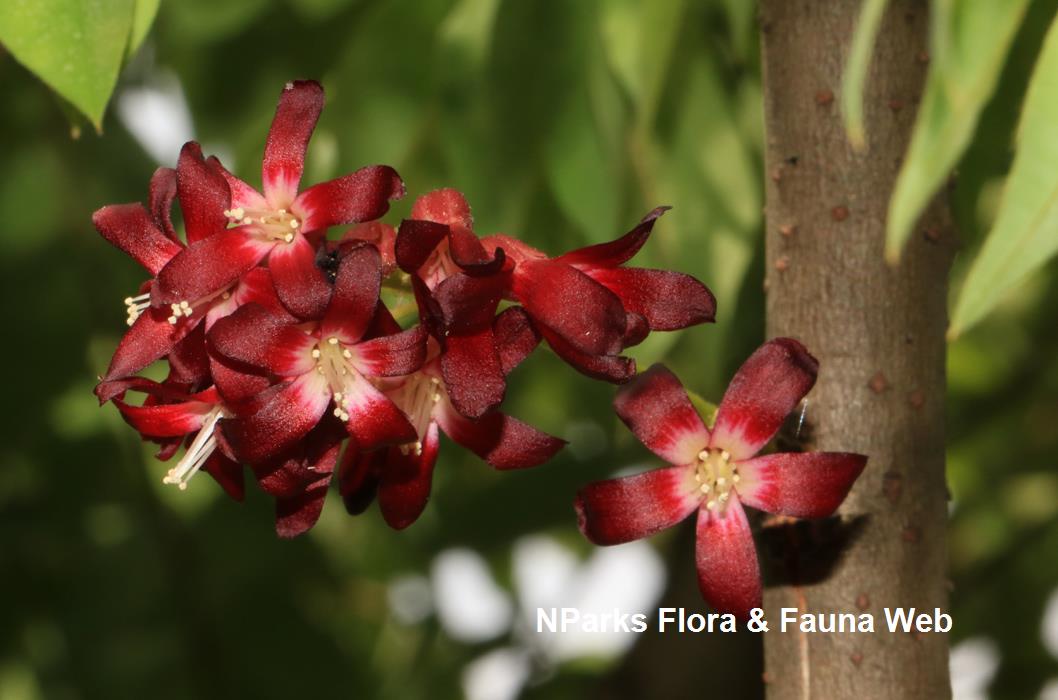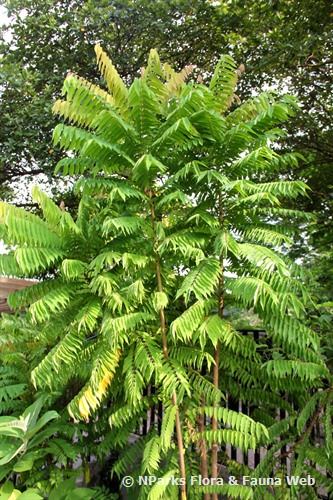
Back
Averrhoa bilimbi L.
| Family Name: | Oxalidaceae |
| Common Name: | Bilimbi, Belimbing Buloh, Cucumber Tree, Belimbing, 木胡瓜 |
Averrhoa bilimbi, also known as Bilimbi, is a small tree, up to 10 m tall. The flowers are purplish red and occur on the trunk or branches in pendulous clusters. At maturity, the fruit is yellowish green and tastes very sour, hence it is usually eaten as a relish.
Name
Classifications and Characteristics
| Plant Division | Angiosperms (Flowering Seed Plants) (Dicotyledon) |
|---|---|
| Plant Growth Form | Tree (Small (6m-15m)) |
| Lifespan (in Singapore) | Perennial |
| Mode of Nutrition | Autotrophic |
| Maximum Height | 10 m |
Biogeography
| Native Distribution | Moluccas, Indonesia, Malaysia |
|---|---|
| Native Habitat | Terrestrial |
| Preferred Climate Zone | Tropical |
| Local Conservation Status | Non-native (Spontaneous (Casual)) |
Description and Ethnobotany
| Growth Form | Small tree, able to grow up to about 5 - 10 m tall. |
|---|---|
| Trunk | Short trunk which branches out into a number of upright branches. |
| Foliage | Green leaves, alternate arrangement and usually clustered at the branch tips, measuring about 30 - 60 cm long, each leaf has about 11 - 37 ovate to oblong leaflets measuring about 2 - 10 cm long and 1.2 cm wide. |
| Flowers | Small purplish-red flowers borne in a pendulous panicle inflorescence, 5-petaled and fragrant, each inflorescence has about 60 flowers. |
| Fruit | Fruit is ellipsoid to obovoid in shape, turns from light green to yellowish-green when ripen, measuring about 4 - 10 cm long. |
| Others - Plant Morphology | Averhhoa bilimbi is closely allied to the Averhhoa carambola (Starfruit), they share some of the same names despite being very different fruits. |
| Etymology | Genus Averrhoa is named after Averrhoes (1126 - 1198), a well-known Arabian philosopher and physician and also a translator of Aristotle's work. Species bilimbi means cucumber tree. |
| Ethnobotanical Uses | Edible Plant Parts : Edible Fruits Food (Herb or Spice) (Fruit or Vegetable): The fruit is too acid for eating raw but the green uncooked fruits are prepared as relish in Suriname. |
Landscaping Features
| Desirable Plant Features | Ornamental Flowers |
|---|---|
| Landscape Uses | General, Parks & Gardens, Small Gardens |
Fauna, Pollination and Dispersal
| Fauna Pollination Dispersal Associated Fauna | Butterfly Host Plant, Bird-Attracting |
|---|---|
| Pollination Method(s) | Biotic (Fauna) |
Plant Care and Propagation
| Light Preference | Full Sun |
|---|---|
| Water Preference | Moderate Water |
| Plant Growth Rate | Moderate |
| Rootzone Tolerance | Moist Soils, Well-Drained Soils, Fertile Loamy Soils |
| Maintenance Requirements | Moderate |
| Propagation Method | Seed |
Foliar
| Foliage Retention | Evergreen |
|---|---|
| Mature Foliage Colour(s) | Green |
| Foliar Arrangement Along Stem | Alternate |
| Leaf Area Index (LAI) for Green Plot Ratio | 3.0 (Tree - Intermediate Canopy) |
Floral (Angiosperm)
| Flower Colour(s) | Red |
|---|---|
| Flower Grouping | Cluster / Inflorescence |
| Flower Location | Axillary, Cauliflorous |
| Inflorescence Type | Panicle |
Fruit, Seed and Spore
| Mature Fruit Colour(s) | Green |
|---|---|
| Mature Seed Colour(s) | Brown |
| Mature Seed Texture(s) | Smooth |
| Seed Description | Small and flattened |
Image Repository
Others
| Master ID | 1442 |
|---|---|
| Species ID | 2735 |
| Flora Disclaimer | The information in this website has been compiled from reliable sources, such as reference works on medicinal plants. It is not a substitute for medical advice or treatment and NParks does not purport to provide any medical advice. Readers should always consult his/her physician before using or consuming a plant for medicinal purposes. |















_lowres.jpg)
